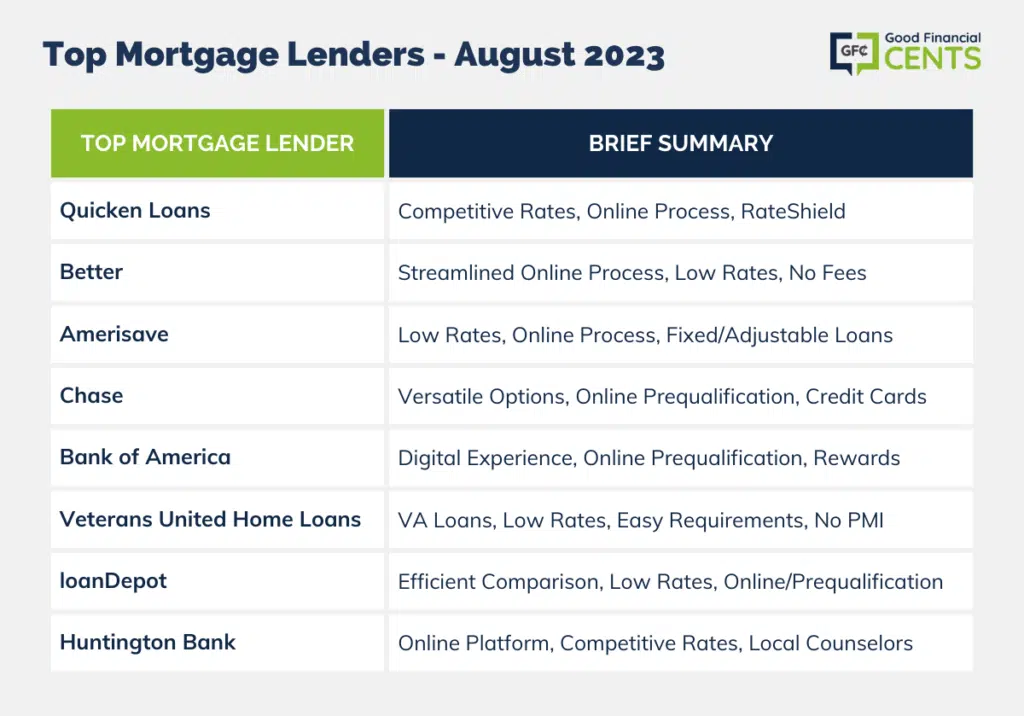Best Home Loan Lenders With Low Interest Rates
Ever wondered how homebuyers secure jaw-dropping deals on their mortgages? It often starts with picking a lender that offers competitive interest rates. A lender with a low-interest rate can save homeowners thousands over the life of a loan.
In the past decade, the landscape for home lending has dramatically evolved, with numerous institutions striving to offer attractive rates to entice borrowers. Interestingly, technological advancements have paved the way for online lenders to join the fray, offering competitive, if not superior, rates compared to traditional banks. This shift provides savvy homebuyers with a broader spectrum of choices towards attaining their dream home affordably.
- Quicken Loans offers competitive rates and efficient online services, making it a top choice.
- SoFi is notable for its flexible eligibility criteria and attractive interest rates.
- Wells Fargo provides tailored loan solutions with reliable customer service.
- Navy Federal Credit Union excels in providing low rates for military members and their families.

Best Home Loan Lenders with Low Interest Rates
Finding the best home loan lenders with low interest rates can significantly impact your financial journey. Online lenders like Rocket Mortgage have competitive rates that appeal to many homeowners. These lenders provide quick approvals and minimal paperwork, making life much easier. Additionally, their modern tools and transparency help customers make informed decisions. No wonder they have grown so popular in recent years.
Traditional banks have long been reliable for home loans. Institutions like Bank of America and Chase offer special rates to attract borrowers. They also provide personalized customer service through their branches nationwide. For many, this face-to-face interaction brings reassurance. Moreover, these banks often bundle home loans with other financial services for added convenience.
Credit unions are another excellent option, often providing lower rates than commercial banks. Navy Federal Credit Union and PenFed are well-known in this space. Credit unions are member-owned, which can lead to more favorable loan terms. Their focus on personalized service often results in higher satisfaction rates among borrowers. This is why many prefer to finance their homes through credit unions.
Non-banking financial companies, or NBFCs, also offer competitive home loan rates. Entities like Tata Capital and HDFC have carved a niche in this sector. These companies often have flexible requirements, catering to a wider audience. They may provide quicker approvals, especially for self-employed individuals. Thus, NBFCs are becoming a go-to choice for many potential homeowners.
1. Online Lenders Offering Competitive Rates
Online lenders have revolutionized the home loan market, offering competitive rates and convenience. Companies like Rocket Mortgage and Better.com make the lending process fast and simple. They use cutting-edge technology to evaluate applications quickly. This means borrowers get approved faster than traditional methods. Many people appreciate the ease with which they can apply from their homes.
One key advantage of online lenders is their lower operating costs. Without the need for physical branches, they can pass savings on to borrowers. This often results in lower interest rates. Additionally, many online platforms offer tools for loan comparisons. This transparency helps users find the best deals with ease.
Online lenders also provide a variety of loan options to suit different needs. From fixed-rate to adjustable-rate mortgages, there’s something for everyone. These choices allow borrowers to find a plan that fits their budget and lifestyle. Furthermore, online lenders often offer special discounts or promotions. Such incentives attract savvy borrowers looking for the best deal.
Many borrowers find that customer reviews and ratings are readily available online. These insights can help potential applicants choose the right lender. Furthermore, digital platforms often have 24/7 customer service. This means help is available whenever it’s needed. The flexibility and support make online lenders an appealing choice for many homebuyers.
2. Traditional Banks with Reliable Loan Options
Traditional banks remain a popular choice for home loans due to their reliability. Banks like Wells Fargo and Chase have decades of experience in the industry. They offer a variety of loan products that cater to different needs and preferences. Customers often appreciate the face-to-face interactions offered at local branches. This personal touch builds trust and can make the loan process feel more secure.
Traditional banks often have strict qualification requirements compared to other lenders. However, they provide comprehensive financial services. Some banks offer bundled services, combining home loans with other products like credit cards and savings accounts. This can mean better rates or special offers. Additionally, banks offer fixed-rate and float-rate loans to meet diverse borrower needs.
Another advantage of choosing a traditional bank is their reputation for stability. Banks usually undergo rigorous regulation and follow strict guidelines. This structure provides additional assurance for borrowers. Moreover, if any issues arise, borrowers can directly visit a branch for assistance. This accessibility makes banks a trustworthy option for many.
Many traditional banks have also embraced modern technology. They offer online tools for applications and account management. This blend of technology and personal service gives customers the best of both worlds. With reliable options and secure processes, traditional banks continue to be a strong choice for securing home loans. Many borrowers find this combination appealing and practical.
3. Credit Unions: A Personalized Approach to Home Loans
Credit unions stand out for their personalized approach to home loans. Unlike big banks, credit unions are member-owned. This means they prioritize the needs of their members over profits. Their focus on community makes them a favored choice for many. Often, they offer lower interest rates compared to traditional lenders.
The application process at a credit union can feel more tailored. Employees take time to understand individual member needs. This can result in more flexible loan options. For those with less-than-perfect credit, a credit union might be more accommodating. Simplicity and support make the borrowing experience smoother.
Credit unions provide a wide range of loan products. From fixed-rate loans to variable rates, there’s something for everyone. Some even offer special programs for first-time homebuyers. This can be beneficial for young families starting out. These options give members the freedom to choose what suits them best.
Membership at a credit union sometimes comes with perks. These might include discounts on interest rates or waived fees. There could also be educational workshops on financial management. Many members feel like part of a community rather than just an account number. This added value enhances the overall lending experience.
Technology is not left behind in credit unions. Many offer online applications and mobile apps for convenience. This makes managing loans easier for tech-savvy members. Combining personal touch with modern tools makes credit unions appealing. The blend of tradition and technology ensures member satisfaction.
4. Non-Banking Financial Companies
Non-banking financial companies, or NBFCs, offer a unique option for home loans. Unlike traditional banks, NBFCs are not allowed to take deposits. However, they can provide loans and other financial products. They often cater to a broader range of customers by offering flexible loan options. This makes them an attractive choice for those with varying financial needs.
One advantage of NBFCs is their quick loan processing. With a focus on efficiency, they usually require less paperwork. This helps applicants receive approvals faster than they might with a typical bank. For people needing urgent funds, this speed is crucial. It’s a big reason why many lean towards NBFCs for their home loan needs.
NBFCs often provide competitive interest rates similar to traditional lenders. They can offer both fixed and variable rate loans. The choice between the two depends on individual preferences. Competitive rates help make home ownership more accessible for many. Furthermore, they have less stringent credit requirements, opening doors for more borrowers.
Many NBFCs also offer specialized financial products. These might include top-up loans or even loans against property. Such versatility allows them to cater to unique financial situations. This is appealing for borrowers seeking more than just standard home loans. The diversity in options sets them apart in the lending market.
The technological innovation within NBFCs cannot be ignored. They utilize modern tools like online applications and AI-driven risk models. This helps streamline processes, making them more efficient. As a result, many borrowers find their services convenient and user-friendly. NBFCs are paving the way for a new generation of lending.
5. Peer-to-Peer Lending Platforms
Peer-to-peer lending platforms provide a unique way for borrowers to access funds. Unlike traditional lenders, these platforms connect borrowers directly with investors. This approach can lower interest rates by cutting out banks or middlemen. Borrowers often find the process more transparent, with clear terms and conditions. It’s an innovative way to finance home purchases that appeals to tech-savvy users.
These platforms, like LendingClub and Prosper, have transformed the lending landscape. They assess credit risks using advanced algorithms, ensuring investors have confidence in their returns. For borrowers, the range of interest rates can vary based on credit profiles. This makes it essential for borrowers to have a good understanding of their credit standing. Doing so helps get more favorable rates.
One of the biggest advantages of peer-to-peer lending is the diversity of options available. Borrowers can choose from a wide range of loan amounts and repayment terms. Some platforms even offer loans for specific purposes, like home improvement. This flexibility helps people find loans that fit their exact needs. It’s a system that provides lots of choice for both borrowers and investors.
The application process on peer-to-peer platforms is typically straightforward. Many offer easy online applications that can be completed in minutes. Once submitted, potential investors review and decide if they want to fund the loan. If approved, funds are deposited quickly, making it a fast and efficient solution. This is especially useful for those seeking quick access to cash.
Despite their benefits, peer-to-peer platforms are not without risk. The lack of regulation compared to traditional banks can pose challenges. Borrowers might face varying interest rates or investor demand. Nonetheless, as more people seek alternatives to traditional banks, peer-to-peer platforms continue to grow in popularity. They offer a fresh perspective on lending and borrowing.
Factors to Consider When Choosing a Home Loan Lender
When selecting a home loan lender, interest rates are one of the most crucial factors to consider. A lower rate can save you thousands over the life of your mortgage. Compare rates from multiple lenders before making a choice. Always check if these rates are fixed or variable. This will help in planning your finances efficiently.
Another important consideration is the lender’s reputation and customer service. Reading online reviews can offer insights into their reliability and support quality. A lender with excellent service can simplify the whole process for you. It’s essential to choose a lender who listens and responds promptly to your queries. This ensures peace of mind while managing your loan.
Look into the fees associated with the loan as well. While some lenders have low-interest rates, they might charge high closing costs or origination fees. Understanding these hidden costs helps avoid surprises later on. Evaluate all aspects thoroughly before finalizing a deal. Sometimes, low upfront prices come at a cost down the line.
The flexibility of loan terms is another vital factor to weigh in on. Some lenders offer adjustable payment schedules or allow extra payments without penalties. Such options give you more control over your repayment plan and can shorten the term of your loan significantly. Discuss these possibilities during consultations with potential lenders to find suitable deals tailored for you.
Lender accessibility and communication channels should not be ignored either. Having easy access to account services through apps or online platforms makes managing your mortgage simpler than ever before, ensuring smooth processing throughout the tenure period while avoiding unnecessary stress along every step taken towards owning that dream house! Choose wisely so that this journey remains enjoyable instead.
Effects of Low Interest Rates on Home Loan Repayment
Low interest rates have a significant impact on home loan repayment. With a lower rate, monthly payments become more affordable. This makes it easier for borrowers to manage their budgets effectively. Families can enjoy extra savings or use them to pay down the mortgage faster. It’s a win-win situation for many homeowners.
When interest rates are low, it also opens up opportunities for refinancing. Refinancing allows homeowners to replace their current loan with a new one at a better rate. This strategy can reduce monthly expenses and decrease the overall interest paid. For those who secured a loan when rates were higher, refinancing is an option worth considering. It helps in achieving long-term financial stability.
Another advantage of low interest rates is that they can increase home-buying power. With lower rates, borrowers might qualify for larger loans. This means they can afford more expensive properties without overly stressing their budgets. The ability to upgrade to a better home becomes a reality. However, borrowers should remain cautious and not exceed their means.
In the broader economic context, low interest rates can stimulate the housing market. More people are likely to take out loans, leading to increased demand for homes. This demand can boost home prices over time. While this is advantageous for current homeowners, it may pose challenges for first-time buyers. Balancing these factors is key to making smart financial decisions.
Finally, with rates at such low levels, lenders become more competitive. They offer attractive loan packages and better terms to attract borrowers. This competition benefits consumers, providing more choices and better deals. Examining these options carefully ensures that borrowers maximize benefits. Staying informed helps ensure that you make the best decision for your financial future.
Exploring Fixed Rate vs. Variable Rate Home Loans
When considering a home loan, it’s essential to understand the difference between fixed rate and variable rate options. A fixed rate loan offers stability. With this choice, your interest rate remains constant for the life of the loan. This means predictable monthly payments, making it easier to budget. Many homeowners prefer this for its simplicity and security.
On the other hand, a variable rate loan is more flexible. The interest rate can change over time, influenced by market conditions. In some cases, rates may start lower than a fixed rate. However, they can increase, leading to higher monthly payments. This option can be risky, but some find it appealing if they expect rates to drop.
Deciding between these two depends largely on your financial situation. If you value long-term predictability, a fixed rate might be the best choice. For those who can handle potential changes in payment amounts, a variable rate offers opportunities for savings. It’s crucial to weigh the pros and cons carefully. It’s all about matching the loan to your financial goals.
Many find a hybrid approach helpful, especially those unsure about long-term stability or market trends. These loans often start with a fixed rate for a set period and then transition to a variable rate. This gives time to adjust if rates increase later. Such features provide additional flexibility. They offer the best of both worlds for some borrowers.
Remember to consider external factors like economic forecasts when choosing between fixed and variable rates. Consulting a financial advisor can provide valuable insights. They can guide you based on current trends and personal circumstances. Thorough research and advice make a significant difference. Making an informed decision ensures you find the most suitable loan type.
The Future of Home Loan Interest Rates
The future of home loan interest rates is a topic of great interest for many homeowners and potential buyers. Economic factors play a significant role in determining these rates. Changes in inflation, unemployment, and government policies can all influence interest trends. Understanding these factors helps in making informed decisions. Many people hope for continued low rates, making homeownership more accessible.
Experts often predict that rates will fluctuate. Many believe that economic recovery could lead to eventual rate increases. This could affect both existing homeowners with variable rate loans and those seeking new loans. Some lenders might adjust their offers in response to these shifts. It’s essential to stay updated on economic news.
Technological advancements are also impacting interest rates. Online lenders use data and algorithms to streamline the lending process. This can result in more competitive rates, as lenders strive to attract customers. Digital platforms may continue to offer attractive packages that challenge traditional banks. Their influence on the market is expected to grow.
Another factor is the role of central banks, like the Federal Reserve. Their decisions on key rates can trickle down to home loan rates. Policymakers often consider broader economic health before making any changes. Their actions are crucial in maintaining balance. Keeping an eye on central bank decisions is wise for those considering home loans.
Finally, global events and uncertainties can also play a part. Political changes, natural disasters, and pandemics can affect economic stability. These elements can lead to unexpected rate shifts. It’s essential to remain flexible and prepared for changes. Planning with these in mind ensures a resilient financial future.
Frequently Asked Questions
Choosing the right home loan lender is key to managing your mortgage effectively. Understanding various aspects of home loans can simplify this decision-making process.
1. What is the difference between fixed and variable home loan rates?
A fixed-rate loan maintains the same interest rate throughout the loan term. This provides stability, as your monthly payments remain constant, making budgeting easier. It’s ideal for borrowers who prefer predictability and want to avoid fluctuations in their monthly bills.
In contrast, a variable-rate loan changes based on market conditions. This means your payments can fluctuate up or down. It’s beneficial if interest rates drop, but it can be risky if rates rise, increasing your payment amounts over time.
2. How do credit scores affect home loan interest rates?
Your credit score plays a vital role in determining the interest rate on your home loan. A higher score typically allows you to qualify for lower rates. This is because lenders view you as less risky and more likely to repay the loan on time.
Conversely, a lower credit score might result in higher interest rates, increasing your loan’s total cost. Improving your credit score before applying can help you secure better terms and save money over the life of the loan.
3. Can refinancing help reduce my home loan interest rate?
Refinancing involves replacing your existing loan with a new one, ideally at a lower interest rate. This can reduce your monthly payments and the total interest paid over the loan’s lifespan. It’s a great option if rates have dropped since you took out your original loan.
However, refinancing comes with its own costs and requirements. It’s essential to evaluate if the potential savings outweigh the costs. Consulting a financial advisor can help you make an informed decision tailored to your circumstances.
4. How does loan-to-value ratio impact interest rates?
The loan-to-value (LTV) ratio is the loan amount divided by the appraised property value. A lower LTV ratio usually results in lower interest rates. This is because lenders see less risk, as there’s more equity in the property compared to the loan.
If your LTV ratio is high, you might face higher interest rates or require private mortgage insurance. Reducing your LTV by making a larger down payment can help you secure more favorable loan terms and minimize costs.
5. What are the pros and cons of using an online lender for home loans?
Online lenders often offer streamlined approval processes and competitive rates. The convenience of applying from home and quick service can be attractive benefits. Their use of technology typically speeds up the loan process, making it ideal for busy borrowers.
However, the lack of face-to-face interaction may be a downside for some. If you value personalized service, a local bank or credit union might be more suitable. Balancing convenience with personalized service is critical when choosing between online and traditional lenders.
Conclusion
Choosing the right home loan lender is crucial for securing favorable terms and managing your financial future. Whether opting for traditional banks, credit unions, or online lenders, each brings unique benefits that cater to different needs. Analyzing factors like interest rates, loan terms, and lender reputation can guide you to the best choice.
Ultimately, being informed helps you make confident decisions that align with your financial goals. Consulting with professionals and staying updated on market trends ensures you remain on the best path towards homeownership. This thoughtful approach can save you money and bring peace of mind.


